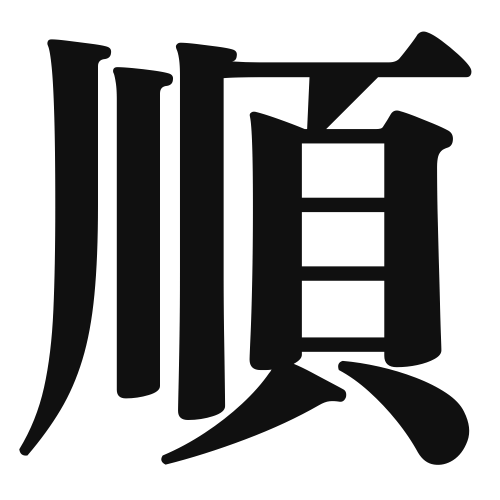1. Overview of Meaning
The kanji “順” (shun) generally means “order,” “sequence,” or “obedience.” It conveys the idea of following a certain arrangement or being in accordance with something.
2. Formation and Radical
The kanji “順” is a compound character (会意文字) that combines elements to convey its meaning. It consists of the radical “彳” (which relates to movement or walking) and the character “君” (which means “lord” or “ruler”). Together, they suggest the idea of following a path or order.
The radical “彳” is often associated with actions related to movement, while “君” adds a sense of authority or guidance, reinforcing the concept of following a prescribed order.
3. Examples of Usage
Common words and phrases that include “順” are:
- 順番 (じゅんばん, junban) – order, sequence
- 順調 (じゅんちょう, junchou) – smooth, favorable
- 順応 (じゅんのう, jun’nou) – adaptation
Example sentences in daily conversation:
- 「次はあなたの順番です。」 (つぎはあなたのじゅんばんです。) – “It’s your turn next.”
- 「プロジェクトは順調に進んでいます。」 (プロジェクトはじゅんちょうにすすんでいます。) – “The project is progressing smoothly.”
4. Synonyms and Antonyms
Similar kanji with related meanings include:
- 整 (せい, sei) – to arrange or organize, which emphasizes the act of putting things in order.
- 秩 (ちつ, chitsu) – order or discipline, which focuses more on systematic arrangement.
Antonyms include:
- 乱 (らん, ran) – chaos or disorder, which signifies a lack of order.
5. Cultural and Historical Background
The kanji “順” is deeply connected to Japanese culture, where concepts of order and harmony are highly valued. In traditional practices, such as tea ceremonies and martial arts, following a specific sequence is essential.
Proverbs and idiomatic expressions that include “順” are:
- 「順風満帆」 (じゅんぷうまんぱん, junpū manpan) – “smooth sailing,” indicating that things are going well.
- 「順を追って」 (じゅんをおって, jun o otte) – “step by step,” emphasizing the importance of following a sequence.
